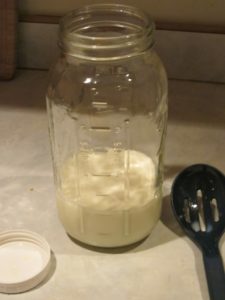What is kefir?
Kefir is made by fermenting milk with the use of special grains yielding a sour, slightly carbonated beverage. The grains used in the fermentation look similar to a small piece of cauliflower. These grains can not be grown from scratch and must either be purchased or obtained from someone currently making kefir. There are many sources on the internet. The grains grow as they ferment the milk, thus anyone making kefir will eventually have excess grains. The grains themselves are a combination of bacteria and yeast, growing symbiotically, which feed upon the sugar in the milk. During the fermentation process the grains produce probiotic bacteria beneficial to digestion.
Why are probiotics good for you?
Probiotics aid digestion by breaking down certain carbohydrates that only probiotic bacteria can digest. They also produce some vitamins and hormones for your body. Probiotics aid immunity by competing for resources with harmful bacteria and, when plentiful, can suppress the effects of harmful bacteria. For more information regarding probiotics see my post on probiotics.
How to make kefir.
Traditionally raw unpasteurized milk is used but pasteurized milk and even milk substitutes such as soy or almond milk can be used. It is also possible to make a water kefir without using milk at all, but this post concerns only milk kefir. I feel the greatest nutrition is derived from raw whole milk.
To make the kefir, place the grains in a clean glass jar, add milk, cover the jar, and leave at room temperature. Some experimentation will be necessary to determine the quantity of milk to add. Depending on the size of the grains, fermentation time, and relative humidity and heat, the kefir will vary in thickness and sourness. For a mild kefir I might suggest starting with a grain the diameter of a nickel, two cups of milk, and just an overnight fermentation. You really can’t do anything wrong. If the kefir is too strong, add more milk next time. If it’s too weak, extend your fermentation time or use less milk.
 |
| I like to label my “resting” grains jar |
After fermenting, strain out the grains and transfer the kefir to a glass jar or container. Because the grains are acidic and will react with certain metals it is safest to never use any metal utensils and to not allow the grains to contact any metal surface. I have read reports that stainless steel will not cause any harm to the grains but I have no personal experience to support or refute that.
If you are going to make more kefir, I prefer to return the kefir grains to the fermentation jar without washing it. I find this make a stronger, thicker kefir. Once I’ve made my kefir supply for the week I put the grains “to rest”. This involves putting the grains in a clean jar with a cup or so of fresh raw milk, covering the jar, and placing it in the refrigerator. The cold temperature in the refrigerator slows the fermentation. You can keep the grains indefinitely by refreshing the milk every week or two. The grains are extremely hardy. I have inadvertently left them for weeks without refreshing the milk and have accidently frozen them without any damage to the grains. When the grains grow big enough to make your fermentation occur too quickly, simply cut them in half with a wooden spoon and eat, compost, or give away your extras.
 |
| Fresh Kefir! |
High temperature in summer may present difficulties as the fermentation will be very rapid. If you find your kefir is separated into curds and whey before you get to it then you need to slow down the process. Place your fermenting kefir in a cool spot such as a basement. If you don’t have access to a basement place the jar inside a cooler with several inches of cool water in it.
How to eat the kefir.
Initially, the most palatable way to consume the kefir is blended in a smoothie. This allows you to disguise the sour taste. Over time you will become more accustomed to the sourness and may eventually be comfortable drinking the kefir straight. Personally I make my kefir very thick, similar in consistency to yogurt. I use two grains and two cups of milk and ferment for a full 24 hours. I then either blend it in a smoothie or pour it directly over granola.
Kefir, it’s easy and it’s great for you. Why not make some?
Kefir, it’s easy and it’s great for you. Why not make some?
Written by Peter Wright
Latest posts by Peter Wright, NTP, CGP (see all)
- Dehydrated Broth – Making It Easy to Drink Broth Every Day! - March 11, 2017
- Lose 10 lbs DURING the Holidays - November 19, 2016
- Finding Good Oils - February 7, 2016



No comments yet.